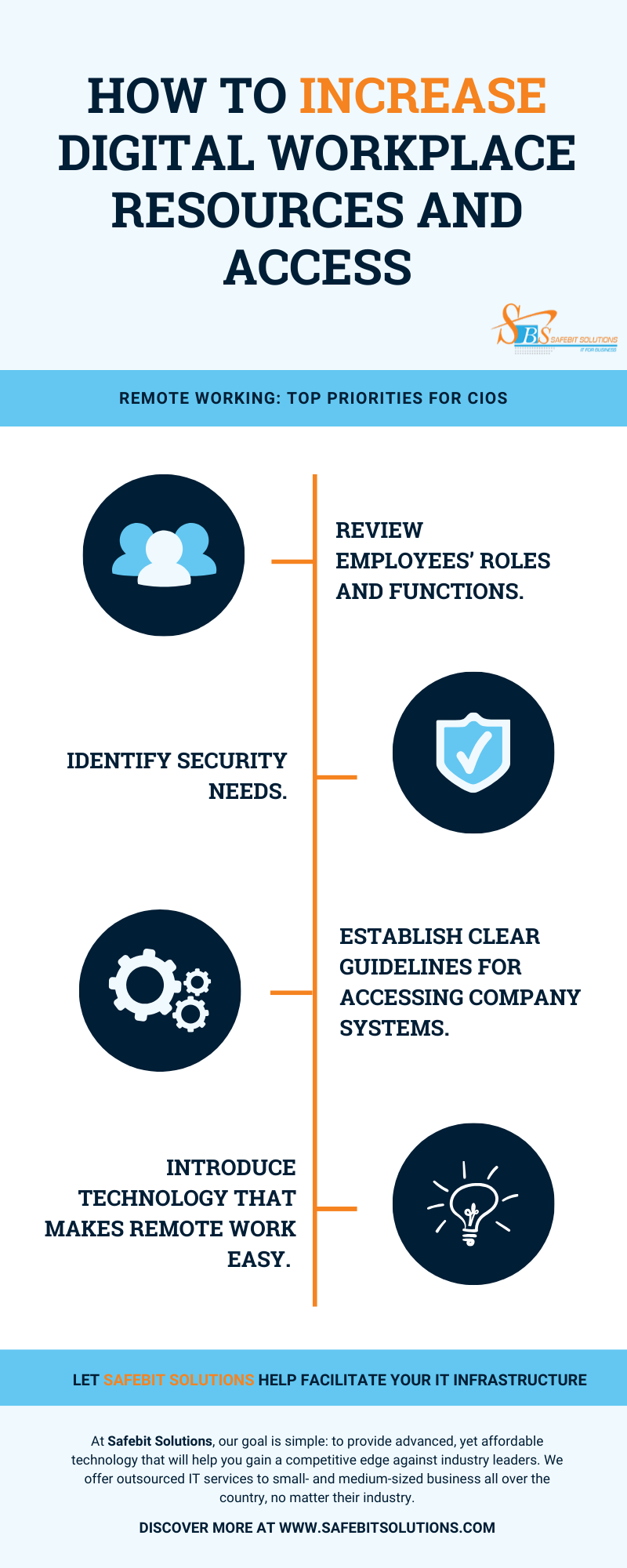The COVID-19 pandemic has caused severe repercussions for economies across the globe — some businesses were forced to shut down, and those that managed to stay afloat are struggling to meet financial goals.
Companies that invested solely in core operational needs found it difficult to adjust to the new normal and continue to carry out day-to-day business activities. Meanwhile, those that leveraged digital platforms were able to accommodate the sudden shift to remote work as well as quickly resume business operations. For many, this pandemic was a wake-up call to rethink business priorities.
As digital channels, products, and operations prove their value in maintaining business continuity during a global crisis, it’s high time that companies take proactive steps to manage their key business functions. Chief information officers or CIOs, in particular, must leverage digital workplace resources and other tools and technologies to meet customer demands.
Increase digital workplace resources and access
To effectively support remote teams, CIOs must ensure that employees have access to company data, files, and programs that they need to remain productive. CIOs can take these steps to provide remote teams with safe and reliable networks:
-
Review employees’ roles and functions. Understanding a remote team’s workflows and processes will allow CIOs to determine the resources they must have access to. These include communication and collaboration tools as well as customer relationship management (CRM) and enterprise resource planning (ERP) systems.
CIOs must also take into account the needs of business partners and customers, and make sure remote teams have the necessary information and tools to address these.
-
Identify security needs. CIOs must assess existing security policies, procedures, and guidelines, and determine which of these can be deployed under the current business environment. Safeguarding access to company resources is equally important as providing it, so it’s crucial to implement a strong remote work security policy.
An effective policy includes tools and tactics to protect systems from remote work-related risks, like connecting to unsafe Wi-Fi networks or using unsecure personal devices to work. For remote employees, multifactor authentication (MFA), a virtual private network (VPN), and a firewall comprise a solid first line of defense against cyberthreats. Meanwhile, baseline protections — or minimum security measures — such as access control, authentication, and encryption are necessary to secure networks.
-
Establish clear guidelines for accessing company systems. CIOs must communicate clear rules and regulations that employees have to follow when accessing company resources remotely. Employees should be oriented on how to access and use these assets correctly and securely. Likewise, they must undergo regular cybersecurity training to help them identify threats and protect essential business resources from being compromised.
-
Introduce technology that makes remote work easy. To facilitate remote work, CIOs can provide employees with tools and applications that simplify their tasks and allow them to collaborate with other remote team members. Videoconferencing, messaging, and real-time collaboration tools, like Microsoft Teams, can help remote teams stay productive and even grow professionally.
However, CIOs will also need to quickly assess business needs and scale IT infrastructures accordingly based on capacity, bandwidth, and the number of users. A managed IT services providers (MSPs) like Safebit Solutions can help with this, and provide other proactive IT solutions that maximize investments and minimize disruptions.
Leverage technology to address customer demands
Whether business demands pick up or slow down, CIOs need to ensure that IT infrastructures are capable of handling any scenario. Implementing technology-enabled solutions is crucial in addressing diverse customer needs and growing a business.
For instance, expanding self-service solutions can address an increasing number of customer queries, complaints, and requests. Instead of having customer service representatives work double-time to respond to these customer demands, CIOs can optimize digital platforms and utilize tools like chatbots to provide better user experiences.
Knowing how to leverage the latest technology can help you continue doing business with minimal downtime and risks during a crisis, and prove to clients and partners that your business is flexible enough to face any challenge. Leave it to Safebit Solutions to help facilitate your IT infrastructure and provide your business with technology to meet diverse demands. Call us today!
Boost Your Company's Productivity!
Before you can honestly consider outsourcing IT management, you need to be 100% confident that it will solve problems and unclog bottlenecks. Our free eBook: 5 Big Ways IT Outsourcing Can Boost Your Company's Productivity should get you to that point, but if it doesn’t, contact us with your questions.




